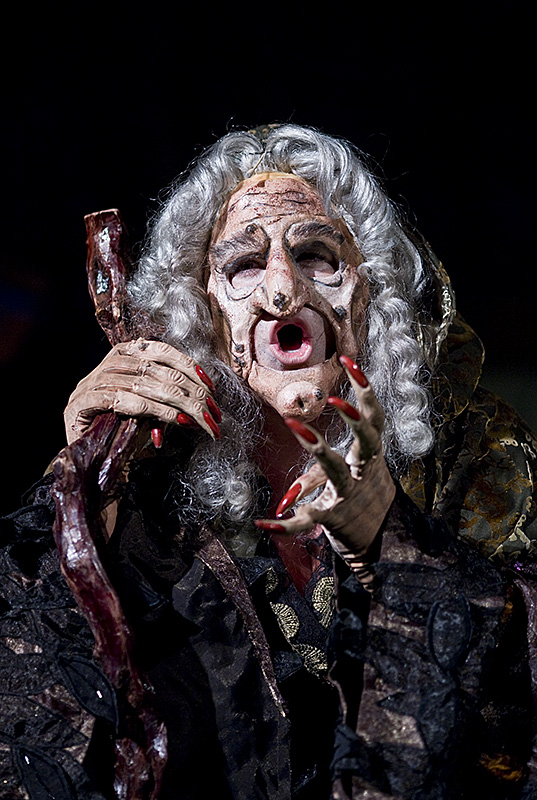Note: This review is based on a dress rehearsal. Performances begin Feb. 11
Once upon a time, the Biola Conservatory of Music decided to change routes, veering off its regular path of an opera production to take a trip “Into the Woods” of musical theater.
Musical spins a twist on a classic
Stephen Sondheim’s “Into the Woods” isn’t far off from an opera, however. Characters spend the majority of the show singing (in English, of course) with very little time in dialogue, while the plot includes dramatic elements found in many operas. Such elements leave Sondheim fans equally pleased and surprised at Biola’s choice for a musical.
With cheating princes, two babies born after undisclosed activities in Rapunzel’s tower–– but still implied–– and other questionable situations, the woods hold far more than a pristine, ever-after ending. In fact, the entire second act takes place after the “happily ever after” we all know from classic fairy tales including Cinderella, Little Red Riding Hood, Rapunzel and Jack and the Beanstalk, with a quick glimpse of Sleeping Beauty and Snow White.
“Woods” moments relate to real life
Upon second look, however, these “moments in the woods” are the very moments of real life. Sondheim, who also wrote the recent musical made into a film “Sweeney Todd,” has a talent for looking into the souls of men and women, portraying the struggles of life on stage in a way that makes his audience think hard about their own lives. Any Christian would do just as well to think about the Christian response to such struggles. The Bible never promises the perfect life. Neither do the fairy tales in “Into the Woods.”
The show focuses on how people deal with their journeys. While the first act contains familiar characters and stories, the plot goes beyond the books. It tells viewers about the Baker and his wife, who gave the magic beans to Jack in exchange for his white cow. They need the cow to help undo a spell placed on the Baker, one that makes his family barren. The Baker acquired the beans from his father, who stole them from the Witch next door. The Witch took her revenge by taking the Baker’s sister, Rapunzel, and raising her as her own. As the Baker and his wife go “into the woods” to undo the spell, they run into Red Riding Hood, Cinderella and other characters.
In the second act, characters are forced to journey back to the woods, after the giant’s wife comes to take her revenge on Jack for killing her husband. The princes are after new princesses, the stepsisters are on their way to a secret hideout, the Baker and his wife have to take care of their new baby and help Little Red Riding Hood and Jack through the woods, and all while the Witch tries to find a way to appease the giant. Meanwhile, Little Red Riding Hood and Jack struggle to cope with the deaths of family. Anyone who has lost a loved one will be especially moved by the “No One is Alone” quartet that Red and Jack sing with the Baker and Cinderella.
Lighter moments balance out the play
In addition to the more serious moments, “Into the Woods” has plenty of humor to balance the mood, and the cast does an outstanding job of lighting up the stage. The evil stepsisters ham it up; the princes agonize over their inability to find the women they love; and Little Red Riding Hood just loves her sweet pastries.
Though young, the cast impresses
For such a young cast, the singers do a great job with the odd beats and discordant tones that make Sondheim’s music difficult to sing. While not one voice is miscast, the Narrator (Trevor Gomes) and Jack (Tyler Wigglesworth) stand out the most with their silly faces and melodramatic characterizations. The Baker (Arnold Geis) and his wife (Kristen Tucker) fit their parts so perfectly, its hard to imagine them any other way. And the Witch (Danielle Evans) is so animated, you never know what to expect.
The costumes enhance, and sometimes outshine, the sets and characters of the show. From the Witch’s wart-covered face to the wolf’s long snout, it would seem no expense was spared in these extravagant clothes. And, as always, the bad guys get all the best costumes.
Unfortunately, the noisy sets sometimes overpower the actors and distract from the action. Transitions between scenes and a few stagings, such as the witch’s disappearance, can also slow and awkward. Despite these drawbacks, the sets make full use of the small stage space. Rafters transport viewers to towers and the tops of trees. The rafters look a little out of place, but thanks to their lush, green surroundings, they serve their purpose without detracting too much from the overall effect.
The first few rows of the auditorium were removed to accommodate a bigger stage as well, allowing for the edition of an orchestra. Backing up the show, the full orchestra plays behind the sets and a mesh screen, a nice change from the typical piano-driven opera production. And audience members will enjoy the small glimpses of players they receive during set changes.
The ticket prices of $15 for students, faculty, staff and senior citizens or $20 general admission may be too high for some, but is well worth it to see Biola’s production of “Into the Woods.”








